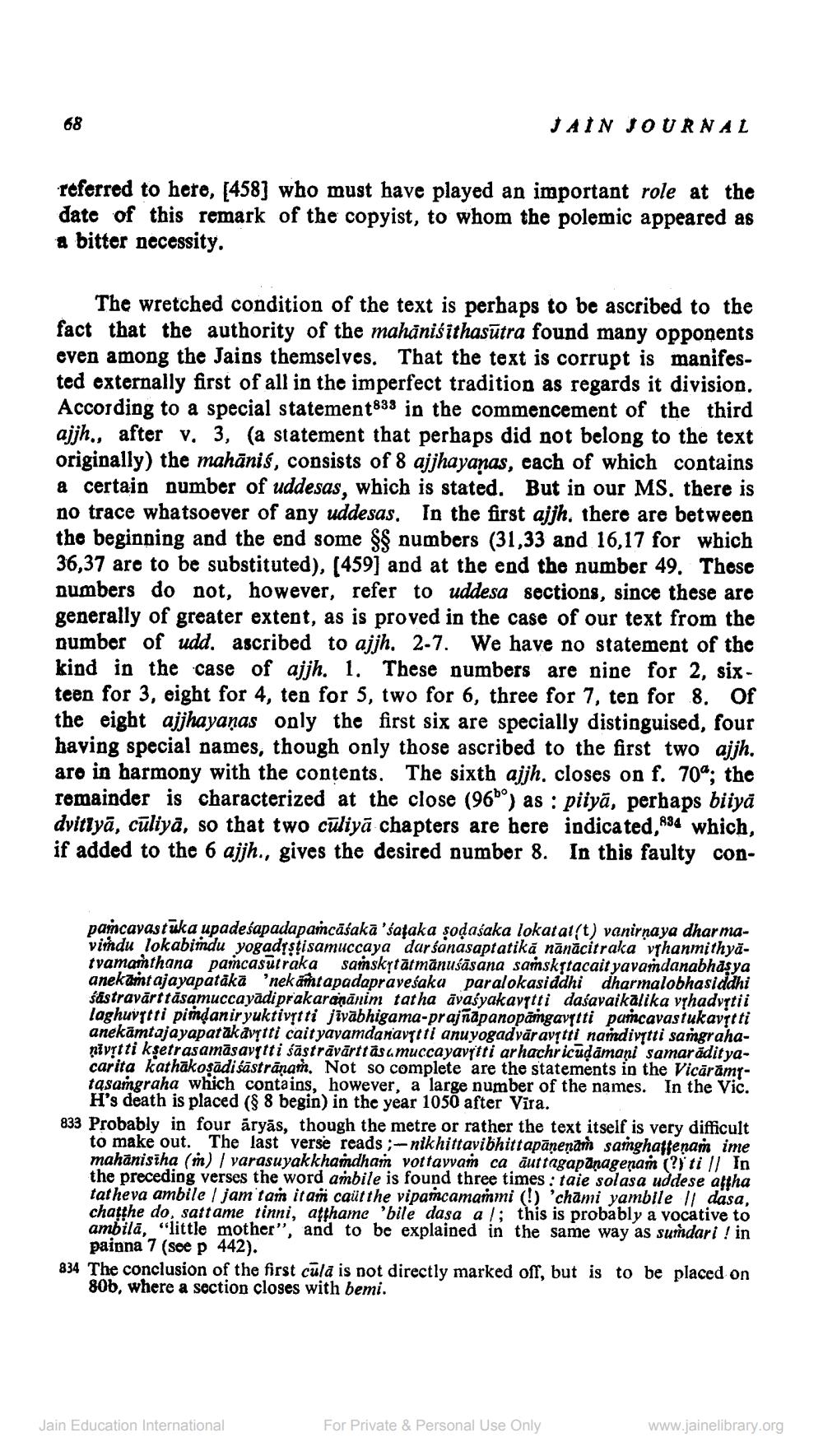________________
68
referred to here, [458] who must have played an important role at the date of this remark of the copyist, to whom the polemic appeared as a bitter necessity.
JAIN JOURNAL
The wretched condition of the text is perhaps to be ascribed to the fact that the authority of the mahāniśithasūtra found many opponents even among the Jains themselves. That the text is corrupt is manifested externally first of all in the imperfect tradition as regards it division. According to a special statement833 in the commencement of the third ajjh., after v. 3, (a statement that perhaps did not belong to the text originally) the mahānis, consists of 8 ajjhayanas, each of which contains a certain number of uddesas, which is stated. But in our MS. there is no trace whatsoever of any uddesas. In the first ajjh, there are between the beginning and the end some §§ numbers (31,33 and 16,17 for which 36,37 are to be substituted), [459] and at the end the number 49. These numbers do not, however, refer to uddesa sections, since these are generally of greater extent, as is proved in the case of our text from the number of udd. ascribed to ajjh. 2-7. We have no statement of the kind in the case of ajjh. 1. These numbers are nine for 2, sixteen for 3, eight for 4, ten for 5, two for 6, three for 7, ten for 8. Of the eight ajjhayaṇas only the first six are specially distinguised, four having special names, though only those ascribed to the first two ajjh. are in harmony with the contents. The sixth ajjh. closes on f. 70%; the remainder is characterized at the close (96) as: piiya, perhaps biiyä dvitiyā, cūliyā, so that two culiya chapters are here indicated,834 which, if added to the 6 ajjh., gives the desired number 8. In this faulty con
pamcavastuka upadeśapadapaṁcāśakā 'śaṭaka ṣoḍaśaka lokatat(t) vanirnaya dharmavimdu lokabindu yogadṛṣṭisamuccaya darśanasaptatikā nānācitraka vṛhanmithyatvamanthana pamcasutraka samskṛtātmānusāsana samskṛtacaityavamdanabhāṣya anekamtajayapatākā 'nekamtapadapravesaka paralokasiddhi dharmalobhasiddhi Sastravarttasamuccayadiprakarananim tatha avasyakavetti daśavaikalika vṛhadvṛtii laghuvqtti pimdaniryuktiv tti jīvabhigama-prajñapanopāmgavitti pamcavastukavtti anekämtajayapatakavṛtti caityavamdanavɣtti anuyogadvaravṛtti namdivytti samgrahanivṛtti kṣetrasamās avṛtti sastrāvarttas &muccayavitti arhachricuḍāmani samaradityacarita kathakoṣādiśāstrāṇam. Not so complete are the statements in the Vicaramytasamgraha which contains, however, a large number of the names. In the Vic. H's death is placed (§ 8 begin) in the year 1050 after Vira.
833 Probably in four aryas, though the metre or rather the text itself is very difficult to make out. The last verse reads;-nikhittavibhittapaneṇam samghattenam ime mahānisiha (m) | varasuyakkhamdham vottavvam ca auttagapaṇagenam (?) ti // In the preceding verses the word ambile is found three times: taie solasa uddese attha tatheva ambile | jam tam itam caut the vipamcamammi (!) 'chami yambile || dasa, chatthe do, sattame tinni, atthame 'bile dasa a /; this is probably a vocative to ambilă, "little mother", and to be explained in the same way as sumdari ! in painna 7 (see p 442).
834 The conclusion of the first cula is not directly marked off, but is to be placed on 80b, where a section closes with bemi.
Jain Education International
For Private & Personal Use Only
www.jainelibrary.org




